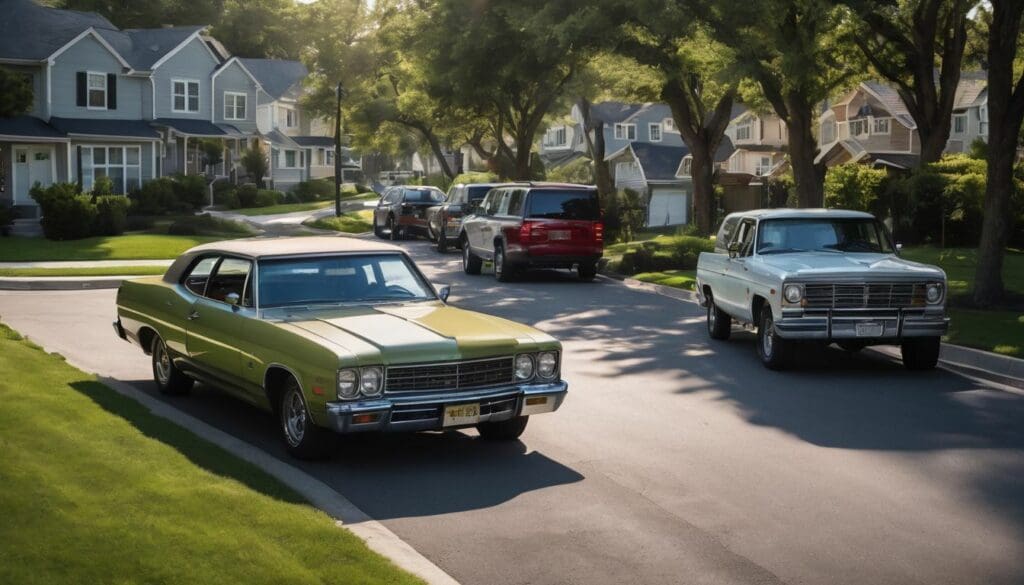Traffic jams during school runs and work commutes are a daily headache for many. A single carpool can cut four cars from the morning rush. Our guide lays out simple steps to create a neighbourhood carpool system, easing congestion and forging community ties.
Let’s ride together!
Key Takeaways
- Carpooling significantly reduces traffic jams, with one car taking the place of multiple vehicles on busy roads.
- By sharing transport, neighbours save money on fuel costs and minimise harmful emissions for a cleaner environment.
- Establishing a carpool creates stronger community bonds as residents collaborate and share daily commuting responsibilities.
- Utilising technology such as apps and social media simplifies organising carpools, making coordination smoother among participants.
- Safety is paramount in a neighbourhood carpool system; rules must be set for drivers and children to ensure secure travel.
The Importance of Community Carpooling
Community carpooling is crucial for reducing traffic congestion and air pollution, as well as helping individuals save money on petrol. It also fosters a sense of community and provides a reliable transportation option, particularly benefiting parents by reducing stress.
Reduce traffic and pollution
Carpooling takes cars off the road, which directly leads to less congestion and fewer emissions choking up our neighbourhoods. It’s a simple equation: more people in one vehicle means fewer vehicles on the street.
This collective effort can make a significant dent in the local carbon footprint, contributing to cleaner air and a healthier environment for everyone. Opting for shared journeys not only promotes sustainable transportation but also echoes our commitment to preserving the planet.
By pooling rides, residents play an active role in cutting down pollutants that lead to smog and poor air quality. Each carpool arranged is a step towards reducing carbon dioxide emissions, easing the burden on urban infrastructure.
Embracing this sharing economy concept of car sharing reflects responsible environmental stewardship and showcases how resident encouragement of eco-friendly practices benefits all community members.
Save money on petrol
To further the benefits of carpooling, let’s consider the financial aspect. Carpooling also helps save money on petrol. Sharing rides means dividing fuel costs among participants, allowing everyone to enjoy savings at the pump.
This not only eases individual expenses but is also an environmentally conscious choice, contributing to reduced fuel consumption and emissions.
As we delve into the practicalities of neighborhood carpool systems, it becomes evident that sharing rides can significantly cut down on expenses related to transportation. By organising and participating in carpool groups, individuals can enjoy substantial savings on petrol while making a positive impact on the environment – a win-win situation for both personal finances and environmental conservation.
Build a sense of community
Encourage neighbours to take turns driving, fostering a community spirit. Organise regular meet-ups for drivers and parents, bringing everyone together. Celebrate successful carpooling initiatives to strengthen bonds between families and promote a collaborative environment within the neighbourhood.
Plan engaging activities for children during their commute, nurturing friendships and fostering camaraderie. Establish clear communication channels among carpool members, facilitating open discussions and promoting mutual respect.
By creating opportunities for meaningful interactions, neighbourhood carpooling can enhance the sense of belonging and cooperation among environmentally conscious individuals focused on conservation efforts.
Provide a reliable transportation option
Ensure accessibility to people who don’t have their own vehicles, ensuring everyone has a way of getting around. It also reduces the number of cars on the road and supports environmental conservation efforts.
These carpooling systems provide a trustworthy transportation option for individuals while contributing to reducing traffic congestion and air pollution.
Reduce stress for parents
When providing a reliable transportation option, reducing stress for parents becomes an essential aspect of community carpooling. By sharing the responsibility of getting children to and from activities or school, parents can alleviate the pressures of daily driving and scheduling.
This in turn fosters a sense of collaboration and support among neighbours, contributing to a more sustainable and connected community.
Embracing the concept of shared transportation not only eases individual burdens but also promotes environmental consciousness by reducing the number of cars on the road. This collaborative effort positively impacts both local traffic congestion and overall air quality while supporting conservation efforts in a practical manner.
Steps for Organising a Carpool System
To organise a carpool system, start by finding suitable candidates and determining the number of kids for each carpool. Create a schedule, establish contact information, consider safety measures, set rules for the children and identify carpool no-nos.
Find suitable carpool candidates
Identify potential carpool members in your neighbourhood or community who share similar routes and schedules. Seek out individuals with a clean driving record, reliable transportation, and a commitment to safety.
Consider factors such as punctuality, flexibility, and willingness to participate in the carpool schedule. Engage in open discussions with potential candidates to ensure compatibility in terms of communication, coordination, and adherence to established carpool rules.
Evaluate the environmental consciousness of potential carpool members as well as their attitude towards conservation practices. Look for individuals who prioritise eco-friendly initiatives and are willing to contribute towards reducing traffic congestion and pollution through regular participation in a neighbourhood carpool system.
Determine the number of kids for each carpool
Consider the number of available seats in each car and the age range of the children involved. Keep in mind the capacity of each vehicle, including any booster or car seats that might be necessary.
Take into account traffic patterns, school schedules, and individual family needs to determine an efficient arrangement for each carpool group.
Balance the number of children while aiming for a manageable load on each driver. It’s important to ensure that all participants feel comfortable with this aspect of the carpool organisation process.
Create a schedule and establish contact information
To establish a neighbourhood carpool system, it is essential to create a clear schedule and establish contact information. This will help in efficient coordination and communication among the carpool participants as well as ensure the safety of all children involved. Here are the steps to achieve this:
- Set up a weekly or monthly schedule that outlines the designated pick-up and drop-off times for each participant.
- Share contact information such as phone numbers and email addresses with all carpool members for easy communication and flexibility in case of any changes or emergencies.
- Utilise technology by creating a shared online calendar or using carpool management apps to keep track of the schedule and contact details.
- Establish a protocol for notifying other members if there are any changes to the predetermined schedule, ensuring everyone is promptly informed.
- Consider creating a group chat or social media group specifically for the carpool participants to facilitate quick communication and updates about any potential changes or adjustments.
- Prioritise safety by ensuring that parents/guardians have access to the contact information of all drivers involved in the carpool arrangement.
- Encourage open communication among all members to address any concerns or issues related to scheduling or logistics, promoting a collaborative and supportive environment within the carpooling community.
Consider safety measures
- Ensure that all drivers have valid licences and maintain their vehicles in good working condition to prevent accidents.
- Set clear rules for car seat usage and seat belt fastening to safeguard the children during transit.
- Plan for emergency situations by having a first aid kit and emergency contact information readily available in each vehicle.
- Establish a reliable communication system between parents and drivers to coordinate pickup and drop-off times effectively.
- Encourage open dialogue about any concerns or changes in routine to maintain transparency and trust among all participants in the carpool system.
- Regularly review and update safety protocols to adapt to changing circumstances and ensure continual improvement in the overall safety of the carpool system.
Set rules for the children
- Seatbelt Safety: Emphasise the importance of wearing seatbelts at all times during the carpool journey.
- Respectful Behaviour: Encourage polite and respectful behaviour towards other passengers, including keeping noise levels to a minimum.
- Timeliness: Stress the significance of being punctual at designated pick-up points to avoid delays for other participants.
- Personal Belongings: Remind children to keep their personal belongings organised and contained within their assigned space.
- Emergency Procedures: Educate children on emergency procedures, including how to exit the vehicle safely if necessary.
Identify carpool no-nos
- Avoiding last – minute changes to the schedule, as this can disrupt other families’ plans and cause inconvenience.
- No tolerance for distracted driving or using mobile phones whilst driving, as it poses a significant risk to all passengers.
- Establishing clear rules about food consumption in the vehicle to maintain cleanliness and respect for others’ belongings.
- Refraining from discussing controversial topics or engaging in heated arguments during carpool rides to maintain a positive atmosphere.
- No altering the predetermined pick-up/drop-off locations without prior agreement, as it can lead to confusion and delays.
Utilising Technology to Organise and Manage Carpools
Explore the use of carpool management apps and social media groups to streamline the organisation and management of your neighborhood carpool system. These tools can help with scheduling, communication, and coordination among carpool participants.
Carpool management apps
Carpool management apps streamline the organisation of carpool schedules and logistics. These user-friendly applications facilitate communication, scheduling, and coordination among carpool participants.
With features like chat functionality, route planning, and real-time tracking, these apps ensure a smooth and efficient carpooling experience for everyone involved. Additionally, they enable easy setting of rules and guidelines to maintain safety standards and enhance the overall commuting experience.
Moreover, carpool management apps provide a platform for environmentally conscious individuals to share rides conveniently while reducing their carbon footprint. By leveraging technology to coordinate carpools efficiently, these apps contribute to promoting eco-friendly transportation options within local communities.
Social media groups
Moving on from carpool management apps, another effective way to organise and manage carpools is through social media groups. These platforms provide a convenient and efficient means of communication, allowing members to easily coordinate schedules, share important updates, and address any issues that may arise.
Social media groups also foster a sense of community among carpool participants and can serve as a forum for sharing tips, advice, and support. By leveraging the power of these online networks, environmentally conscious individuals can collaborate with like-minded neighbours to establish successful neighbourhood carpool systems.
With private carpooling groups established on social media platforms such as Facebook or WhatsApp, participants can quickly connect with one another and make arrangements for pick-up times, drop-off locations, and other logistical details.
Tips for a Successful Carpool
– Effective communication and planning are essential for a successful carpool, ensuring that all participants are on the same page.
– Getting to know the other drivers in your carpool can help build a sense of trust and cooperation, leading to a more enjoyable experience for everyone involved.
Communicate and plan effectively
Effective communication and planning are crucial for a successful carpool. Coordinate with other parents to establish clear schedules, rules, and emergency contact information. Stay in regular touch to ensure everyone is informed of any changes or updates.
Use a combination of methods such as group chats, online calendars, and direct messages to keep lines of communication open. Plan ahead to effectively manage pick-up and drop-off times, ensuring that all children’s needs are accounted for.
By staying organised and communicating openly with fellow parents involved in the carpool, you can create a positive experience for both the kids and the environment.
Get to know the other drivers
Connect with the other drivers in your carpool group. Share contact details and establish open lines of communication. Discuss important topics such as pick-up and drop-off points, any allergies or medical conditions to be aware of, and emergency procedures.
Understanding each other’s needs and expectations will help ensure a smooth and successful carpooling experience.
Engage in regular conversations to build trust and foster cooperation within the group. Consider scheduling a meeting or gathering outside of carpool hours to get to know each other better.
Prioritise safety
Ensure the safety of all children involved by thoroughly vetting potential carpool candidates. Strictly enforce seat belt usage for every child during the carpooling process to avoid any accidents or injuries.
Regularly inspect the condition of vehicles used in the carpool system and keep an updated list of emergency contact information for each participant. Never compromise on following traffic rules and regulations to guarantee a secure transportation environment.
Consider creating a set of well-defined safety guidelines that outlines how parents can be assured their children are safe when participating in carpooling activities, including specific pickup and drop-off locations and protocols in case of emergencies.
Consider the needs of all children involved
Prioritise the needs of all children involved in the carpool, taking into account their specific requirements. Ensure that each child feels comfortable and safe during the journey.
Account for any allergies or medical conditions when planning snacks and drinks for the carpool. Plan routes that accommodate the individual drop-off points of each child to reduce travel time and inconvenience.
Consider any special equipment or belongings that may need to be transported with each child, such as sports gear or musical instruments.
Conclusion
In conclusion, establishing a neighbourhood carpool system can reduce traffic and pollution. By saving money on petrol and providing reliable transportation options, it builds a sense of community.
Organise carpools through offline conversations and utilise social media groups to share rides effectively. Implementing carpool etiquette and coordination ensures the success of your community carpool system.
FAQs
1. How can I start a neighbourhood carpool system?
To establish a neighbourhood carpool system, you can begin by organising carpool groups through offline conversations or social media carpooling platforms to encourage community building and neighbourly cooperation.
2. What are some important rules for carpool etiquette?
Carpool etiquette includes setting clear carpooling rules like agreeing on a schedule, defining pick-up points, establishing how costs are shared, and deciding on how communication about the ride sharing will happen.
3. Can employers set up their own employee carpool programme?
Yes, employers can organise an employee carpool programme to facilitate ride sharing among workers which helps reduce traffic and promotes team bonding.
4. Where can people find public carpooling groups?
People looking for public carpooling groups can often find them on social media platforms dedicated to ride-sharing, local bulletin boards or through apps designed for coordinating carpools.
5. Are there any tips for effective communication within the carpool group?
Effective communication in a carpool involves creating detailed profiles with contact information and preferences as well as using group chats or dedicated apps for easy coordination of the daily commuting plan.





